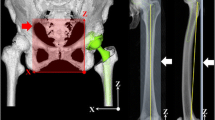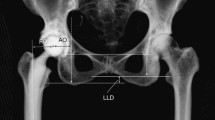Abstract
Purpose
The purpose of this study was to evaluate whether femoral antetorsion affects the range of motion (ROM) following total hip arthroplasty (THA) using 3D dynamic analysis.
Methods
Using 3D computed tomography (CT) data of 71 patients (71 hips) who underwent THA, we calculated antetorsion of the femoral neck, flexion range of motion (Flex ROM), internal rotation (Int-R) and external rotation (Ext-R). Evaluation of the relationship between antetorsion, ROM and the impingement site was performed. As for implant position, anteversion of the femoral implant was set to be the same as natural antetorsion of the femoral neck, and the acetabular component was set 45° of total anteversion in all cases.
Results
We found a significant decrease in Flex ROM and Int-R inversely proportional to femoral antetorsion. In patients with lower antetorsion, Flex ROM and Int-R decreased due to bony impingement (the anterior great trochanteric region of the femur impinges on the anteroinferior edge of the anteroinferior iliac spine). However, in Ext-R, there was no relationship between ROM and femoral antetorsion.
Conclusions
We demonstrated that lower femoral antetorsion substantially affects Flex ROM and Int-R due to bony impingement. For these patients, consideration must be given to retaining femoral anterior offset in THA.




Similar content being viewed by others
References
Caton J, Prudhon JL (2011) Over 25 years survival after Charnley's total hip arthroplasty. Int Orthop 35(2):185–188
D’Lima DD, Urquhart AG, Buehler KO, Walker RH, Colwell CW Jr (2000) The effect of the orientation of the acetabular and femoral components on the range of motion of the hip at different head–neck ratios. J Bone Joint Surg Am 82:315–321
Bozic KJ, Lau EC, Ong KL, Vail TP, Rubash HE, Berry DJ (2012) Comparative effectiveness of metal-on-metal and metal-on-polyethylene bearings in Medicare total hip. J Arthroplasty 27(8):37–40
Caton JH, Prudhon JL, Ferreira A, Aslanian T, Verdier R (2014) A comparative and retrospective study of three hundred and twenty primary Charnley type hip replacements with a minimum follow up of ten years to assess wether a dual mobility cup has a decreased dislocation risk. Int Orthop 38(6):1125–1129
Nevelos J, Johnson A, Heffernan C, Macintyre J, Markel DC, Mont MA (2013) What factors affect posterior dislocation distance in THA? Clin Orthop Relat Res 471(2):519–526
Morrey BF (1997) Difficult complications after hip joint replacement. Dislocation. Clin Orthop Relat Res 344:179–187
Jolles BM, Zangger P, Leyvraz PF (2002) Factors predisposing to dislocation after primary total hip arthroplasty. A multivariate analysis. J Arthroplasty 17:282–288
Bartz RL, Nobel PC, Kadakia NR, Tullos HS (2000) The effect of femoral component head size on posterior dislocation of the artificial hip joint. J Bone Joint Surg Am 82:1300–1307
Lewinnek GE (1978) Dislocations after total hip-replacement arthroplasties. J Bone Joint Surg Am 60:217–220
Dorr LD, Malik A, Dastane M, Wan Z (2009) Combined anteversion technique for total hip arthroplasty. Clin Orthop Relat Res 467(1):119
Lachiewicz PF, Soileau ES (2013) Low early and late dislocation rates with 36- and 40-mm heads in patients at high risk for dislocation. Clin Orthop Relat Res 471(2):439–443
Garbuz DS, Masri BA, Duncan CP, Greidanus NV, Bohm ER, Petrak MJ, Della Valle CJ, Gross AE (2012) Dislocation in revision THA: do large heads (36 and 40 mm) result in reduced dislocation rates in a randomized clinical trial? Clin Orthop Relat Res 470(2):351–356
Dorr LD, Wan Z, Malik A, Dastane M, Deshmane P (2009) A comparison of surgeon estimation and computed tomographic measurement of femoral component anteversion in cementless total hip arthroplasty. J Bone Joint Surg Am 91:2598–2604
D’Lima DD, Urguart AG, Buehler KO, Walker RH, Colwell CW (2000) The effect of the orientation of the acetabular and femoral components on the range of motion of the hip at different head neck ratios. J Bone Joint Surg Am 82:315–321
Widmer KH, Zurfluh B (2004) Compliant positioning of total hip components for optimal range of motion. J Orthop Res 22:815–821
Kessler O, Patil S, Stefan W, Mayr E, Colwell CW, D’Lima DD (2008) Bony impingement affects range of motion after total Hip arthroplasty: a subject-specific approach. J Orthop Res 26(4):443–452
Rousseau MA, Lazennec JY, Boyer P, Mora N, Gorin M, Catonné Y (2009) Optimization of total hip arthroplasty implantation: is the anterior pelvic plane concept valid? J Arthroplasty 24(1):22–26
Incavo SJ, Thompson MT, Gold JE, Patel RV, Icenogle KD, Noble PC (2011) Which procedure better restores intact hip range of motion: total hip arthroplasty or resurfacing? A combined cadaveric and computer simulation study. J Arthroplasty 26(3):391–397
Shoji T, Yasunaga Y, Yamasaki T, Mori R, Hamanishi M, Ochi M (2013) Bony impingement depends on the bone morphology of the hip after total hip arthroplasty. Int Orthop 37:1897–1903
Ranawat CS, Rao RR, Rodriguez JA, Bhende HS (2001) Correction of limb length inequality during total hip arthroplasty. J Arthroplasty 16:715–720
Suzuki K, Matsubara M, Morita S, Muneta T, Shinomiya K (2002) CT image evaluation of the internal rotation limit prior to bony impingement after total hip arthroplasty. J Orthop Sci 7:433–438
Burroughs BR, Hallstrom B, Golladay GJ et al (2005) Range of motion and stability in total hip arthroplasty with 28-, 32-, 38-, and 44-mm femoral head sizes. J Arthroplasty 20(1):11–19
Schileo E, Taddei F, Cristofolini L, Viceconti M (2008) Subject-specific finite element models implementing a maximum principal strain criterion are able to estimate failure risk and fracture location on human femurs tested in vitro. J Biomech 41:356–367
Dorr LD, Wan Z (1998) Causes of and treatment protocol for instability of total hip replacement. Clin Orthop Relat Res 335:144–151
Dorr LD, Wolf AW, Chandler R et al (1983) Classification and treatment of dislocations of total hip arthroplasty. Clin Orthop 173:151–158
Author information
Authors and Affiliations
Corresponding author
Rights and permissions
About this article
Cite this article
Shoji, T., Yasunaga, Y., Yamasaki, T. et al. Low femoral antetorsion and total hip arthroplasty: a risk factor. International Orthopaedics (SICOT) 39, 7–12 (2015). https://doi.org/10.1007/s00264-014-2452-5
Received:
Accepted:
Published:
Issue Date:
DOI: https://doi.org/10.1007/s00264-014-2452-5




